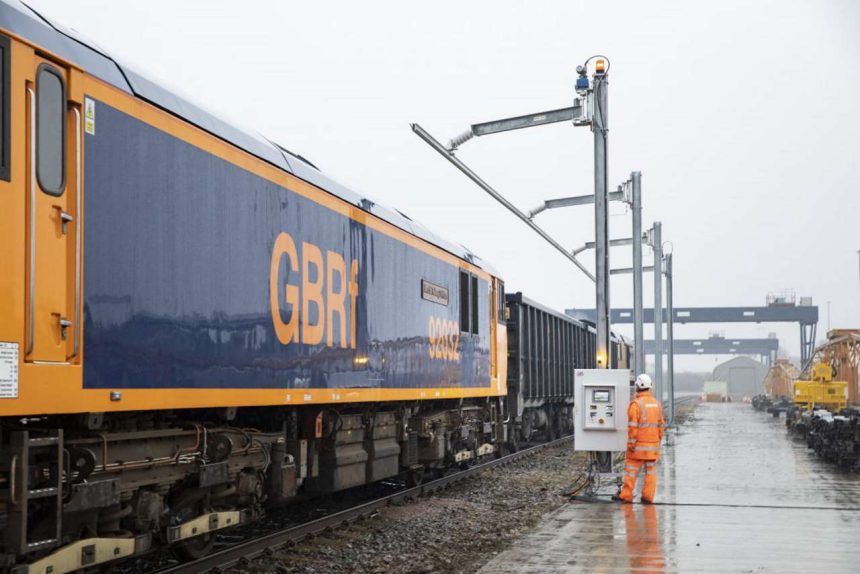A rail freight terminal in Northamptonshire has become the first in the UK to demonstrate an innovative overhead electrification system, which could spell the end for diesel on electrified rail routes and boost the industry's net-zero ambitions.
Freight trains are usually loaded and unloaded from above, which prevents the use of the high voltage overhead lines as used on the main line. Diesel engines are therefore used to move freight trains in and out of terminals, which may cause delays to passenger trains when they are held up by slower diesel-hauled freight trains on the main lines, or waiting to be moved into a depot by a shunter.
To overcome the use of diesel engines in freight terminals, engineers from Furrer+Frey GB have designed a moveable overhead conductor system where overhead equipment supplying power to electric locomotives can be moved safely away once the train is in place, and returned when the train needs to move again.
Furrer+Frey's system is being trialled in partnership with GB Railfreight at an aggregate facility run by Tarmac at Wellingborough in Northamptonshire. The facility is adjacent to the Midland Main Line which is currently being electrified and upgraded by Network Rail as part of the Government's Integrated Rail Plan, to increase capacity for passengers and freight trains. The system being trialled at Wellingborough is based on one developed by Furrer+Frey for passenger train depots and is in use by Eurostar and LNER.
If the trials are successful, the moveable overhead system could go on to be deployed at other freight terminals across the UK as a step towards the full decarbonisation of Britain's railways.
The Decarbonisation & Electrification of Freight Terminals (DEFT) project is funded by the Department for Transport and Innovate UK. The DEFT concept was endorsed by members of the Rail Forum Midlands in 2020 as a viable method to decarbonise UK rail freight, leading to the successful funding bid to InnovateUK and the Department for Transport.
Rail Minister Wendy Morton said: “It is fantastic to see winners of our First Of A Kind competition getting out there and helping transform the railways for the better.
“Making rail freight even more environmentally friendly helps us leap forward in our plans to build back greener and make the whole UK net-zero by 2050.”
Noel Dolphin, Head of UK projects at Furrer+Frey GB, said: “The electrification of freight terminals is the biggest technological hurdle to net-zero rail freight and we have just overcome it. The demonstrator shows how we can plug freight yards into electrified rail lines and operate them safely and efficiently with the locomotives we already have – meaning greener, cleaner and better journeys.
“This moveable conductor system means trains pull in on electricity, disconnect from it to safely load and unload, then reconnect to travel on.
“I'm proud of our team and partners for getting us to this milestone moment today showing a greener future for the industry.”
Chris Swan, Head of Rail at Tarmac, said: “Decarbonising transport has been highlighted as one of the key areas in which we can help achieve net zero across the construction industry.
“Supporting this exciting project is just the latest step in the ongoing development of our rail freight capabilities, which forms part of Tarmac's wider commitment to reducing CO2 across the whole business.
“We're always keen to explore new initiatives and innovations that can help us move materials to the right place at the right time more efficiently and sustainably.”
John Smith, CEO GB Railfreight, said: “Rail freight is already a greener alternative to moving goods by road but innovations like the Moveable Overhead Conductor System, and electrification more broadly, will allow us to go even further.
“At the same time as combatting climate change, they also bolster operations, and the reliability and efficiency of rail freight.
“We continue to work with the UK government to fulfill our industry's potential and this is a great example of what can be achieved when the industry and government work together effectively.”

This sounds like a great advancement for freight depots, and we have Wendy Morton, Noel Dolphin, Chris Swan and John Smith all saying the same thing about the decarbonisation of the railway – which is fair enough, but it would have been good to have had someone who explained how the system actually works.
That’s amazing. Plus having overhead conductor rail bar that is energised at 25,000v AC is lot better than having copper wires with the same voltage.
Perhaps there should be a similarly removable system for the third rail DC system so that yards and depots could be safely energised.
Perhaps there should